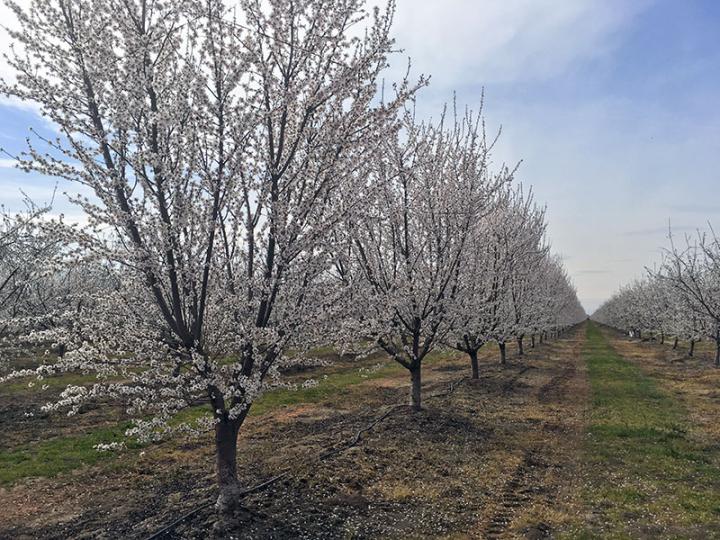
Mar 9, 2022Hard freeze devastates valley tree crops
Tim Taylor walked one of his almond orchards in Sutter County last week, collecting blossoms off the trees for samples. A cold spell at the end of February had plunged much of the Sacramento Valley into record-low territory, and Taylor was out to assess the damage.
“Every flower can produce an almond,” Taylor said. “When that freeze hits and these are developing, when they’re younger – when they’re brand new – you can get a little colder on them. But once they start to develop like this” – he sliced into a blossom to check the developing nut – “see that black inside? That means it’s frozen. It froze, and it’s dead.”
The toll only added up. Taylor estimates that 60% of his orchard was damaged by the freeze, potentially decimating his yield. It was dispiriting news after expectations for a bountiful year.
“We had a wonderful February,” Taylor said. “We had lots of warm days this year, the bees were working hard, and we thought we’re going to have a bumper crop this year. It was looking pretty darn good until all of a sudden it decided to freeze for four days.”
Similar scenes are playing out up and down the Central Valley, where temperatures reached the low to mid-20s most of President’s Day week.
“With each passing day, or with each passing week, you lose frost tolerance,” said Mel Machado, director of member relations at Blue Diamond Growers. “At full bloom, I figure 28’s the magic number; anything 28 (degrees) or below at full bloom, I’m going to start to see some damage.”
Machado said it’s too soon to know the total crop losses. “The first clue of what’s going to hang in the trees is normally about the end of March, and the first clue of what you might actually get to harvest is the end of April,” he said.
Kelly Evans, Taylor’s wife, said she needs to see what the trees will shed over the next month. Preliminary estimates are showing a wide range—from “fared out pretty well” to “a complete loss” in some orchards.
“Is the tree going to drop the stuff that was burnt, or is it going to drop some of the good nuts that are left? We don’t know yet,” Evans said. “We’re in a holding period for the next 30 days to figure out what will be left of the crops.”
Glenn County saw its share of damage as well. Mike Vereschagin, who grows almonds near Orland, said bloom came about 10 days earlier than last year.
“We had one of the best blooms we’ve had in a long time,” Vereschagin said. “The potential was for a huge crop this year, and the frost took all that away here.”
Many growers hired helicopters in a bid to warm up the trees, he added.
“Sounded like a military zone out there with all the helicopters flying, trying to push down the warmer air from above into the orchards,” Vereschagin said.
For that to work, there has to be an inversion layer; Machado said it was light to nonexistent this time.
“One guy told me he had a helicopter at 200 feet before it found anything warm,” Machado said. “That’s useless. You need to have air 30, 40 feet off the canopies to make that work.”
When a freeze is in the forecast, farmers can use water to fight off damage – up to a point.
“If I know it’s getting cold, I’ll come out here at 10:30 at night, or midnight, or 2 a.m., and we start irrigating,” Taylor said. Water coming out of the ground is 50 to 52 degrees, he added, and can raise the temperature in the orchard a degree or two in much the same way hot shower water warms up a bathroom.
“If it’s only 30 degrees, you can do pretty well,” Taylor said. “But like last week, we got 25, 26 degrees out here. You can only raise it a couple of degrees. You’re at 28 degrees, and it just starts taking its toll.”
Agricultural commissioners have been collecting data to support a potential disaster declaration. Growers in counties that are declared disaster areas have access to relief programs through the U.S. Department of Agriculture’s Farm Service Agency.
Lisa Herbert, Sutter County’s agricultural commissioner, said the disaster threshold is 30% damage across the entire county, and this one may span as many as five counties.
“We know for certain the almonds have issues, but there are preliminary reports that we may be seeing some damage in prunes as well,” Herbert said. “It’s pretty early to tell, but those are the things that we will be looking at moving forward.”
Colusa County Agricultural Commissioner Anastacia Allen said the first step is documenting everything. She and Herbert encouraged farmers with damage reports to contact the office or visit their websites.
“As the season progresses, we’ll work along with (University of California Cooperative) Extension and other experts in the field to confirm that, yeah, this is going to be a loss, that they are completely lost at this point,” Allen said. “It’s very early, but yes, it looks like the losses are going to be pretty severe.”
– Kevin Hecteman, California Farm Bureau







